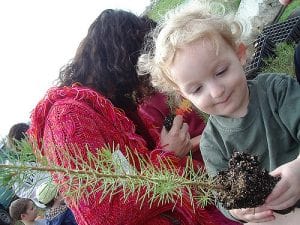February 10, 2019 - Tu BiShvat
Tu BiShvat (Ti BiShavat, Tu B'shevat, Tu B'Shevat, Tu Bishvat) is the Jewish new year for trees. It occurs on the 15th day of the Shvat month in the Jewish calendar. This is a lunisolar calendar, which means that the months are based on the lunar cycle, but years are based on solar years. This keeps Jewish holidays around the same time of year, but since the months are based on the lunar cycle, the date of the holiday each year. In Judaism, the age of a tree is important in determining whether you can eat the fruit from it. The fruit from a tree cannot be eaten for the first three years, and the fourth year’s fruit is only for G-d. After the four years, you can eat the fruit from a tree. Tu BiShvat is the day that each tree ages a year for the purposes of determining if one can eat from it.
This holiday is a minor Jewish holiday, and it is not mentioned in the Torah. Scholar believe that this holiday started originally as an agricultural festival celebrating spring in Israel. However, after the destruction of the Second Temple in the year 70 C.E. (stands for Common Era, and refers to the same time period as A.D.), many Jews were exiled and the agricultural celebration stopped. Over time, some Jews felt a need to symbolically bind themselves to their homeland, and Tu BiShvat was a way to fill that need. They introduced a new ritual, the Tu BiShvat Seder. This Seder (a ceremonial dinner) is similar to the Seder at Passover. The Seder involves eating biblical foods native to the holy land. As a part of this, people eat fruit and the seven spices of Israel. The fruit is typically grapes, figs, pomegranates, olives, or dates, as they are mentioned in the Torah as food from the Holy Land. Some families would have a 15-course meal, and each course would be one of the foods associated with the land.
Nowadays, Tu BiShvat is an environmental holiday. Jews consider this day as a way to remind themselves of their duty to care for the natural world. Many Jews take part in a tree-planting ceremony, or collect and send money to Israel for them to plant a tree there. Here in Boston, this time of year is not a good time to plant trees, so many people send money through the Jewish National Fund Tree Planting Center to plant a tree in Israel. Some families also hold a Seder, similar to the one they will hold for Passover, and consume traditional foods for this meal.
Here are a few good books to read with your kids to learn about the significance of Tu BiShvat:
February 14, 2019 - Valentine's Day
Valentine’s Day is a cultural holiday celebrated in the United States and in many places around the world, to honor St. Valentine. However, the story of how this day became associated with romance is not as straightforward as it seems.
Ancient Romans used to celebrate a festival called Lupercalia from February 13 – 15. On this day, Roman men would sacrifice a goat and a dog, and then hit women with the skins of those slain animals. The women lined up to be hit, because they believed it would make them fertile. After, men would draw a woman’s name from a jar and those two would become a couple for the rest of the festival. If the couple was well matched, they might continue to stay together after the end of the festival.
Later, in the 5th century, St. Valentine’s Day was created by the Catholic Church. The church created this day to honor two priests Emperor Claudius II executed on February 14 (in different years), who were both named Valentine. By placing this day during the time of Lupercalia, St. Valentine’s Day began to take on some of the earlier meaning associated with the original festival.
The connection between St. Valentine's day and love only became stronger through the years. Around the 1400s, Geoffrey Chaucer associated the mating of birds on February with St. Valentine’s Day. He wrote in his “Parlement of Foules”:
“For this was on seynt Volantynys day. Whan euery bryd comyth there to chese his make.”
Soon, English nobility began to send love notes during bird-mating season. For example, the French Duke of Orléans, wrote to his wife in February 1415 that she was his “very gentle Valentine.” Almost 200 years later the tradition continued in Shakespeare's Hamlet,written in 1599. In Hamlet, Ophelia, refers to herself as Hamlet’s Valentine. More recently, with the industrial revolution, cards were able to be made in the factory, instead of by hand. In 1913, Hallmark Cards started mass producing valentine cards, and they took off from there.
Many people today continue to associate the day with romance, and they celebrate by doing something romantic with someone special. The more traditional displays of romance on this day are flowers, chocolates, or going to a nice dinner. In addition, many elementary school children are required to get valentine cards and hand them out to each person in their class, so that no one feels left out on this romantic day. If you're not interested in Valentine's Day, see our Valentine's Day Survival Guide!
Read more about the holiday with your kids or for your own interests here:
Łes el da̕ de san valentn̕! (it's valentine's day!)
If there's a particular celebration you or someone you know participates in that we missed, let us know by leaving a comment on this post. Or, if you think we got something wrong, please also comment and let us know. We try to be as accurate as possible, but if there's a mistake, we want to correct it.




Add a comment to: The Origins and Practies of Holidays: Tu BiShvat and Valentine’s Day